|
|
 |
|
Calanoida ( Order ) |
|
|
|
Clausocalanoidea ( Superfamily ) |
|
|
|
Phaennidae ( Family ) |
|
|
|
Onchocalanus ( Genus ) |
|
|
| |
Onchocalanus magnus (Wolfenden, 1906) (F,M) | |
| | | | | | | Syn.: | Xanthocalanus magnus Wolfenden, 1906 (p.32, Descr.F, figs.F);
Onchocalanus frigidus Wolfenden, 1911 (p.276);
no O. magnus : Wolfenden, 1911 (p.275); Sewell, 1948 (p.574);
no O. magnus : With, 1915 (p.225, figs.F);
? O. magnus : Hardy & Gunther, 1935 (1936) (p.163, Rem.) | | | | Ref.: | | | Brodsky, 1950 (1967) (p.234, figs.F, Rem.); Vervoort, 1950 a (p.17, figs.F, Rem.); 1951 (p.92, Rem.); 1957 (p.87, figs.M, Rem. | 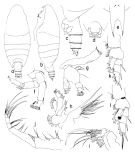 issued from : T. Park in Antarct. Res. Ser. Washington, 1983, 39 (5). [p.344, Fig.16]. Female: a, habitus (dorsal); b, idem (lateral left side); c, urosome (lateral left side); d, genital segment (ventral); e, rostrum (anterior); f, A2; g, Md; h, Mx1; i, Mx2; j, Mxp; k, P1 (posterior); l, P1 (anterior).
|
 issued from : T. Park in Antarct. Res. Ser. Washington, 1983, 39 (5). [p.345, Fig.17]. Female: a, P2 (posterior); b, P3 (posterior); c, P4 (posterior); d, P5 (posterior).
|
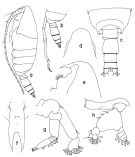 issued from : T. Park in Antarct. Res. Ser. Washington, 1983, 39 (5). [p.346, Fig.18]. Male: a, habitus (lateral left side); b, last thoracic segments with P5 and urosome (lateral left side); c, last thoracic segments and urosome (dorsal); d, forehead (dorsal); e, idem (lateral); f, rostrum (anterior); g, A2; h, Md.
|
 issued from : T. Park in Antarct. Res. Ser. Washington, 1983, 39 (5). [p.347, Fig.19]. Male: a, Mx1; b, Mx2; c, Mxp; d, distal part of left P5 (posterior); e, P5 (posterior).
|
 Issued from : W. Vervoort in Zool. Verh., Leiden, 1950, 10. [p.17, Fig.5]. Female (from 67°S, 16°W): a, posterior part of cephalothorax and urosome (lateral left side) with spermatophore attached to genital operculum; b, right P5 (posterior aspect, another specimen); c, posterior part of cephalothorax and urosome (from the same specimen). Nota: Head and 1st thoracic segment, as well as 4th and 5th separated. Anal segment very short (± telescoped into the 3rd urosomal segment.
|
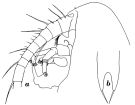 Issued from : W. Vervoort in Zool. Verh., Leiden, 1950, 10. [p.18, Fig.6]. Female (from 67°S, 16°W): a, cephalon (lateral left side, oral parts more or less schematic, Mx1 omitted); b, rostrum (ventral view).
|
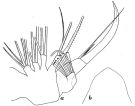 Issued from : W. Vervoort in Zool. Verh., Leiden, 1950, 10. [p.19, Fig.7]. Female (from 67°S, 16°W): a, right Mx2; b, forehead (dorsal).
|
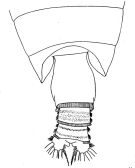 Issued from : W. Vervoort in Zool. Verh., Leiden, 1950, 10. [p.20, Fig.8]. Female (from 67°S, 16°W): a, posterior part of cephalothorax and urosome (dorsal). Nota: The abdominal segments and furca in the proportional lengths 49:22:15:4:10 = 100.
|
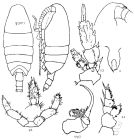 Issued from : K.A. Brodskii in Calanoida of the Far Eastern Seas and Polar Basin of the USSR. Opred. Fauna SSSR, 1950, 35 (Israel Program for Scientific Translations, Jerusalem, 1967) [p.235, Fig.146]. Female (from NW Pacif.):habitus (dorsal and lateral left side); forehead (lateral); R, rostrum; Mp1, Mx2: S1, P1; S3, P3; S5, P5.
|
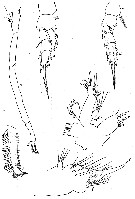 issued from : W. Vervoort in B.A.N.Z. Antarctic Reseach Expedition, Report Ser. B, Vol. III., 1957 [Fig.70] Male (from 66°33'S, 45°32'E): a, P5 (lt = left leg; rt = right leg); b, distal portion of left P5; c, left P1 (posterior); d, left P2 (posterior); e, left Mx1; f, left Mx2. Nota: Mx1 with reduction in size of the spines on the 1st inner lobe, 10 setae that with a single exception are only weakly chitinized, the shape of these setae can be derived from fig.70e; the 2 nd inner lobe has 2, the 3 rd inner lobe has 4 setae, all of which are thin; 1 st outer lobe with 7 setae (9 in female) and 10 setae on the exopod; the 2 nd basal segment has 5 setae; the endopod consists of 3 indistinctly separated segments, the 1 st and 2 nd have 3 setae, the 3 rd has 4 rather strong setae. Right P5 very short; the left enormously elongated, being twice as long as the abdomen and 11 times as long as the right P5; 1 st basal segment of left and right foot fused; right foot, moreover, with 1 intermediate segment, carrying a pectiniform row of hairs along the external border, and a terminal segment which terminates into a short, blunt point; the left foot consists of 2 basal segments and 3 exopodal segments, of which the basal two segments and the 1 st exopodal segment are almost tubiform; the 1 st exopodal segment also has a small spine at the end of the external margin, 2 nd exopodal segment smaller, with a notch at the beginning of the external border and 2 strong hairs at the end of the internal margin; 3 rd exopodal segment curiously shaped and greatly haired, the apical portion set off from the rest of the segment, it carries a distinct spine.
|
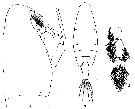 issued from : R.N. Wolfenden in Die Marinen Copepoden der Deutschen Südpolar-Expedition 1901-1903, 1911. [Pl.XXXI, Figs.3-5]. With doubt. Female: 3, habitus (dorsal); 4, cephalosome (lateral); 5, P5.
|
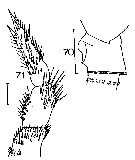 Issued from : J.M. Bradford in N.Z. Oceanogr. Inst., 1971, 206, Part 8, No 59. [p.22, Fig.70, 71]. Female (from 75°09'S, 171°00'W): 70, genital segment (left side); 71, P5. Scale bar: 1 mm (70); 100 µm (71).
|
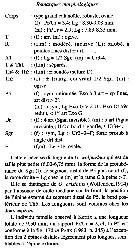 Issued from : C. Razouls in Ann. Inst. océanogr., Paris, 1994, 70 (1). [p.106]. Caractéristiques morphologiques de Onchocalanus maghus femelle et mâle adultes. Terminologie et abbréviations: voir à Calanus propinquus.
| | | | | Compl. Ref.: | | | ? Lysholm & Nordgaard, 1921 (p.19); Grice & Hulsemann, 1968 (tab.2); Morris, 1970 (p.2300); Björnberg, 1973 (p.331, 388); Deevey & Brooks, 1977 (p.256, tab.2, Station "S"); Hopkins & Torres, 1988 (tab.1); Hattori, 1991 (tab.1, Appendix); Thueesen & al., 1998 (p.95, metabomism vs locomoyion); Bradford-Grieve & al., 1999 (p.880, 929, figs.F); Voronina & Kolosova, 1999 (p.71); Razouls & al., 2000 (p.343, tab. 5, Appendix); Yamaguchi & al., 2002 (p.1007, tab.1); Ikeda & al., 2006 (p.1791,Table 2); Galbraith, 2009 (pers. comm.); Homma & Yamaguchi, 2010 (p.965, Table 2); Homma & al., 2011 (p.29, Table 2, 3, abundance, feeding pattern: suspension feeders); | | | | NZ: | 8 | | |
|
Distribution map of Onchocalanus magnus by geographical zones
|
| | | | | | | | |  issued from : W. Vervoort in B.A.N.Z. Antarctic Reseach Expedition, Reports - Ser. B, Vol. III, 1957 [Fig.71]. issued from : W. Vervoort in B.A.N.Z. Antarctic Reseach Expedition, Reports - Ser. B, Vol. III, 1957 [Fig.71].
Chart showing the geographical distribution (white circle) in the seas surrounding the Antarctic continent.
Nota: In this chart the area frequented by whaling vessels has been hatched. The Antarctic circle (66°.5 S) has been drawn as a broken line. The numbers I to VI refer to the sectors into which the Antarctic seas are divided according to Mackintosh (1942) (after Vervoort, 1951). |
| | | | Loc: | | | Antarct. (Peninsula, Weddell Sea, SE Atlant., Indian, SW & SE Pacif., Ross Sea), ? South Georgia, sub-Antarct. (SE Pacif.), Sargasso Sea (in Deevey & Brooks, 1977, p.264, Station "S" : 32°10'N, 64°30'W), ? off S Iceland, SW Indian (in Grice & Hulsemann, 1967, p.16), Japan (off Sanriku), SE Hokkaido, Station Knot, Bering Sea, S Aleutian Basin, S Aleutian Is., Alaska Peninsula, off British Columbia (rare), off Is. Juan Fernandez, Chile | | | | N: | 28 | | | | Lg.: | | | (15) F: 9,08-8,3; M: 8,33-7,83; (22) F: 6,2; (25) F: 8,46; M: 7,88; (31) F: 8,8-8,6; (64) F: 8,8; (102) F: 8,75; (208) F: 6,5; {F: 6,20-9,08; M: 7,83-8,33} | | | | Rem.: | Bathypelagic.
Sampling depth (Antarct., sub-Antarct.) : 0-2000 m. Sargasso Sea: 1500-2000 m (Deevey & Brooks, 1977, station "S");
According to Brodsky (1950, p.234) the form, described by Esterly (1906 a) as Xanthocalanus similis is a juvenile of O. magnus, but this is neither followed by Vervoort (1950 a), nor Park (1983 a, p.335, 339) and Bradford et al., 1983 (p. 61, 66). | | | Last update : 24/09/2018 | |
|
|
 Any use of this site for a publication will be mentioned with the following reference : Any use of this site for a publication will be mentioned with the following reference :
Razouls C., Desreumaux N., Kouwenberg J. and de Bovée F., 2005-2025. - Biodiversity of Marine Planktonic Copepods (morphology, geographical distribution and biological data). Sorbonne University, CNRS. Available at http://copepodes.obs-banyuls.fr/en [Accessed January 05, 2026] © copyright 2005-2025 Sorbonne University, CNRS
|
|
 |
 |

















